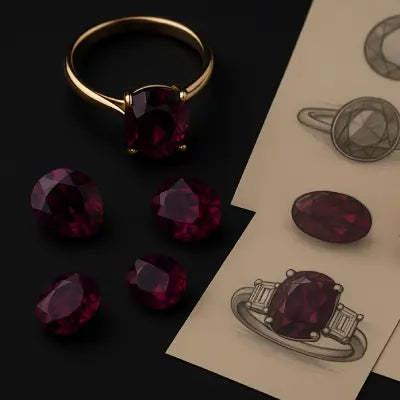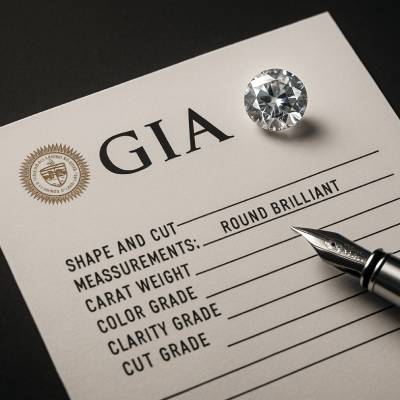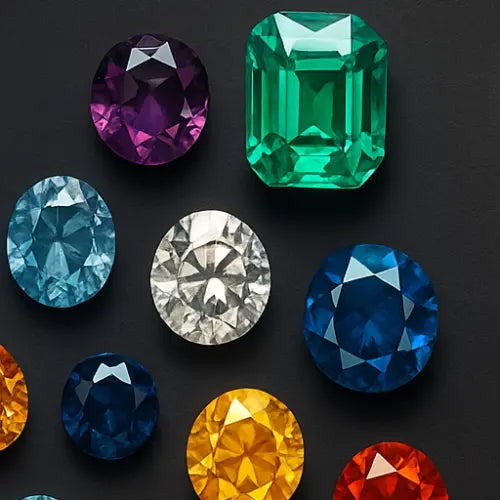The Role of Precious Metals in Custom Jewelry Designs
Custom accessories go beyond simple decoration. They become:
- A personal expression.
- A treasured heirloom.
- A symbol of an important moment.
Before starting, an important decision must be made: which type of metal to use for your jewelry. From the elegance of platinum to the glow of gold, the options you select greatly impacts:
- The aesthetics.
- Durability.
- The meaning of your piece.
Our article will delve into the interplay between metals and custom design. It guides you through the factors to consider. It will help you craft a piece that speaks volumes about your vision.
Introduction to Precious Metals in Jewelry
The foundation of any great custom design is the metal you choose. In this block, we will go beyond aesthetics. We will talk about how the metal influences a piece's:
- Durability.
- Functionality.
- Symbolism.
Selecting the best metal for jewelry making is key to laying the foundation for a masterpiece.
Popular Options:
- Gold. As the quintessential component, it offers timeless elegance and a luxurious feel.
- Platinum. It’s renowned for its strength and durability. It’s ideal for everyday wear.
- Sterling Silver. A timeless and affordable choice, it offers a classic shine and a versatile canvas for intricate details.
- Palladium. It provides a budget-friendly alternative. It's hypoallergenic and relatively lightweight. It makes it comfortable for everyday wear.
Popular Metals Used in Jewelry
Here's a closer look at some of the most popular jewelry metal types:
- Gold. It’s the undisputed king of metals. It exudes timeless elegance and warmth. It naturally occurs in a vibrant yellow hue. However, it's also available in rose and white ones. Pure gold is quite soft. To enhance durability and achieve specific colors, it's often mixed with others. They are copper and silver. The percentage of gold present is measured in karats (K). 18K signifies 75% gold. Meanwhile, 14K indicates 58.5% gold content.
- Silver. Among the best metals alternatives for jewelry making is sterling silver. It’s a beloved choice for its classic shine and versatility. It's composed of 92.5% pure silver and 7.5% alloy metals. They are copper, for example. It adds strength. Silver is perfect for intricate designs and pairs beautifully with colorful gemstones. However, it needs regular cleaning to maintain its brilliance.
- Platinum. It's renowned for its strength and resistance to scratches. It’s the choice for those seeking a lifetime investment piece. Its naturally white color makes it perfect for diamonds. It's more expensive than gold. However, durability ensures an item will withstand the test of time.
- Alloys. What is alloy jewelry? It refers to a mixture of two or more metals. Jewelers often use them to enhance the properties of valuable metals. For example, alloying gold with copper increases its durability. It allows for more intricate and delicate designs. Similarly, copper strengthens silver and adds a touch of warmth to its cool sheen. Alloys can also be used to create entirely new colors, like the rosy hue of rose gold. It’s achieved by mixing gold with copper.
Choosing the Best Metal for Different Jewelry
Here's a guide to navigating this crucial decision based on the type of accessories:
- Rings. Rings, especially engagement and wedding bands, are meant to endure daily wear. Platinum is the strongest metal for rings. It takes the crown for its exceptional strength and resistance. It's a wise choice for active lifestyles. Also, it ensures your ring will keep its pristine beauty for years to come. However, if budget is a concern, consider 14K or 18K gold. These options offer a good balance between durability and affordability. It's especially in styles that are less prone to heavy wear and tear.
- Necklaces. Necklaces offer more flexibility in selection. What are good necklaces made of? For statement pieces, consider the bold elegance of sterling silver. Its affordability allows for larger, more intricate designs. And this goes without breaking the bank. For a lighter option or to focus on low maintenance, palladium is fantastic. Hypoallergenic properties make it ideal for sensitive skin. And its natural luster shines beautifully. For a touch of luxury, 18K gold adds a timeless elegance. It’s especially when it’s paired with gemstones.
- Earrings. Earrings demand a delicate balance between beauty and comfort. Since they adorn your ears throughout the day, weight becomes a crucial factor. What metal is best for earrings? Lightweight options like sterling silver and palladium are ideal. They are for everyday wear, especially for intricate designs with dangling elements. Gold, particularly 14K or 18K, offers a luxurious option that's still comfortable for most wearers. Nickel-free alloys are a must for those with sensitive skin. Also, consider the closure type. Studs with secure butterfly backs are ideal for everyday wear. Meanwhile, hoops might require a stronger, slightly heavier component like 14K gold for security.
Durability and Aesthetics
Striking the right balance between durability and aesthetics is paramount:
- Durability. For everyday wear, use solutions renowned for their strength and scratch resistance. Among the best materials for jewelry is platinum. It offers resilience against everyday bumps. High-karat gold (14K or 18K) is another excellent choice. It provides a good balance between strength and affordability. For special occasions, you might need flexibility. Sterling silver offers a stunning shine. It allows for intricate designs at a lower price point. However, it requires more frequent cleaning to maintain its brilliance. Palladium provides a hypoallergenic and low-maintenance alternative. However, it might not be as strong as platinum.
- Aesthetics. Gold comes in a variety of colors. They are yellow, rose, white. Those are to complement different palettes. Silver exudes a classic charm. And it works beautifully with colorful gemstones. For a modern, edgy vibe, consider stainless steel. It's known for its durability and sleek, contemporary look.
- Identifying Your Component. Knowing the type of component your item is made of allows you to care for it properly. Many pieces will have a small hallmark stamp indicating the metal content. For example, "14K" signifies 14-karat gold, while "925" represents sterling silver (92.5% silver). If unsure, consult a jeweler. They can identify the metals and advise on cleaning and maintenance.
- Wearability and Maintenance. Consider how comfortable the accessory will be for everyday wear. Lightweight materials like sterling silver and palladium are best for earrings and delicate necklaces. Gold offers a luxurious feel in a range of weights depending on the karat. For those with sensitive skin, opt for hypoallergenic options. They are platinum, palladium, or nickel-free alloys. Remember, maintenance plays a role, too. Gold and platinum require minimal upkeep, while silver tarnishes and needs regular cleaning.
Metals and Customization Options
Custom items are a canvas for self-expression. And the component you choose becomes your artistic foundation. Each jewelry-making metal offers unique features. These offer many customization options that can bring your vision to life:
- Engraving Your Story. For intricate details and personalized touches, certain metals shine. Sterling silver's affordability and softness allow artisans to create crisp engravings. Those beautifully contrast its sheen. Platinum offers a luxurious, subtle canvas for engravings. It's due to its natural white color. However, it requires a more experienced hand for intricate designs.
- Shaping Your Dreams. If your vision features delicate details, consider the malleability. 18K gold's softness is ideal for jewelers to create detailed and airy designs, like filigree work or intricate gemstone settings. Rose gold, with its warm, contemporary feel, boasts similar malleability. Remember, softer types of jewelry metals require more delicate handling.
- Making a Statement. For those who crave a bold look, certain options lend themselves perfectly to striking designs. Stainless steel's inherent strength allows for clean lines and geometric shapes. It's ideal for contemporary pieces. Black rhodium plating on silver or white gold creates a dramatic and edgy feel.
- Unlocking Endless Possibilities. Understand how different jewelry metal types respond to customization techniques. Then, you can unlock endless creative possibilities. Discuss your vision with a skilled jeweler who can guide you toward the perfect component to achieve your desired level of detail and overall aesthetic. Together, you can transform your vision into a stunning piece of custom accessories.
Conclusion
Jewelry-making metals are the foundation upon which breathtaking custom items are built. From the timeless elegance of platinum to the warm glow of rose gold, the one you choose significantly impacts your piece's aesthetics, durability, and even its ability for customization.
Selecting the right option isn't just about aesthetics. It's about creating a piece that complements your lifestyle and personal expression. Consider the intended use of the accessories. For a ring meant to be worn daily, you need the strongest metal, like platinum. Meanwhile, a statement necklace can embrace the bold beauty of silver.
Remember to know how to tell what kind of metal jewelry is. The perfect harmony lies in marrying practicality with your unique vision. Don't hesitate to consult a skilled jeweler who can guide you through the world of valuable metals and help you transform your dream into a reality.






